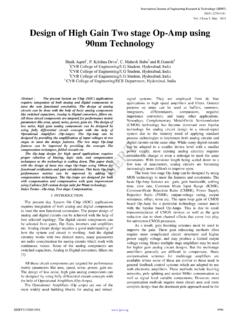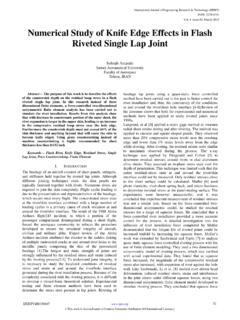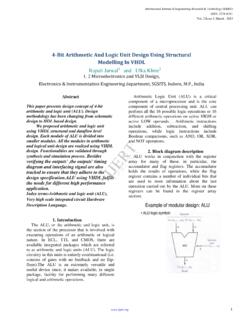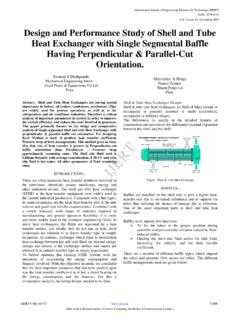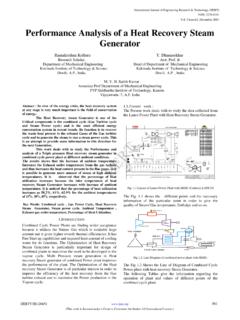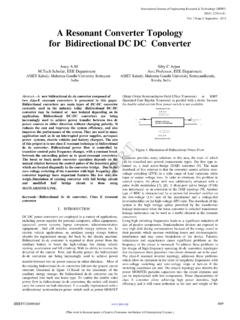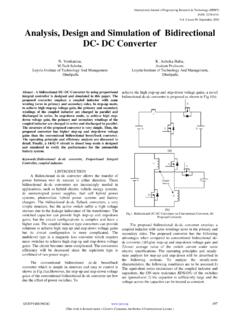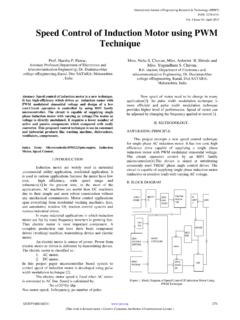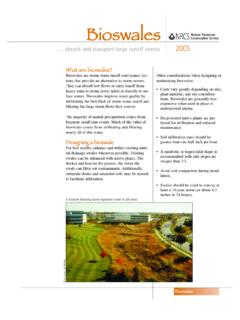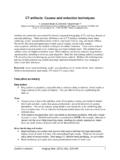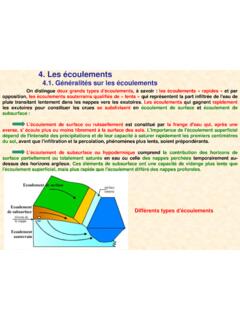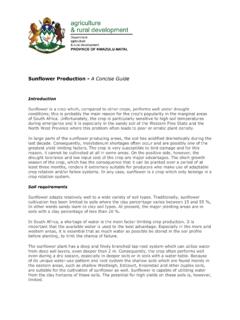Transcription of Study on Methods and Techniques of Retrofitting
1 Komal Bedi GNIET Nagpur Abstract The retrofit process is a general term that may consist of a variety of treatments, including: preservation, rehabilitation, restoration and reconstruction. Selecting the appropriate treatment strategy is a great challenge involved in the retrofit process and must be determined individually for each project. Depending on project objectives, preservation and renovation of buildings may involve an array of diverse technical considerations, such as fire life safety, geotechnical hazards and remedies, weathering and water infiltration , structural performance under earthquake and wind loads.
2 1. Introduction Preservation is defined as the process of applying measures to sustain the existing form, integrity, and materials of a historic property. Rehabilitation refers to the process of creating new application for a property through repair, alterations and additions while preserving those features which convey it s historical, cultural, or architectural values. Restoration is the process of accurately restoring a property as it existed at a particular period of time. Reconstruction is described as the act of replicating a property at a specific period of time. Rehabilitation provisions require selecting the rehabilitation objectives and acquiring current building information prior to performing rehabilitation design.
3 At the stage of selecting the Retrofitting method, the current status of the existing structure and its performance are known, and the performance required for the structure after Retrofitting . Factors that should be considered in selecting the method include the effectiveness of the various Retrofitting Methods with respect to the required performance improvements, the viability of execution of the Retrofitting work, the impact of the Retrofitting work on the surrounding environment, the ease of maintenance after Retrofitting , economy and other factors. 2. Retrofitting of Concrete Members Continuous fiber reinforced plate bonding construction method: Bonding continuous fiber reinforced plates to the surface of the existing structure to restore or improve load-carrying capacity Continuous fiber reinforced plate jacketing construction method: Jacketing with continuous fiber reinforced plates around the periphery of the existing structure to restore or improve load-carrying capacity and deformation characteristics Prestressed concrete jacketing construction method.
4 Placing prestressing wires and prestressing stranded steel wires in place of lateral ties around the periphery of existing member sections and using mortar and concrete to bond them in order to reinforce the structure. Prestressing introduction construction method: Using internal cables for the existing concrete members to provide prestressing and restore or improve the load-carrying capacity of the members. Repaving method: Replacing some or all of the existing concrete members with new members through the use of precast members or concreting on site to restore or improve load-carrying capacity.
5 Study on Various Methods and Techniques of Retrofitting621 International Journal of Engineering Research & Technology (IJERT) ISSN: 2 Issue 9, September - 20133. Retrofitting as a Structural Body Beam addition method: Adding beams between the main girders of the existing reinforced concrete deck to reduce the deck span and restore or improve the load-carrying capacity of the reinforced concrete deck. Seismic wall addition method: Placing new reinforced concrete walls between existing reinforced concrete rigid-frame bridge piers and bonding them to form a continuous unit in order to restore or improve the load-carrying capacity as a structural body.
6 Support point addition method: Supporting the intermediate sections of the beams and other existing concrete members with new members to reduce the span of the members in order to restore or improve the load-carrying capacity as a structure. Seismic Isolation method: Using seismic isolation bearings and the like to reduce the seismic energy applied to the structure in order to improve its various performance values during an earthquake. 4. Foundation Retrofitting Underground wall (beam) addition method: Connecting the foundations with cast-in-site diaphragm walls and underground connecting beams to distribute stress and ensure the stability of the entire system.
7 Pile/footing addition construction method: When pile foundations are damaged or there is residual displacement, adding piles or footings to increase the load-carrying capacity of the foundation. Foundation improvement method: Improving the ground around the foundation with cement improvement materials to improve the ground bearing capacity and horizontal foundation resistance. Also prevents excessive pore water pressure and liquefaction. Steel sheet-pile coffering construction method: Placing sheet-piles around the periphery of the footings and bonding them to the footings to improve bearing capacity and horizontal resistance.
8 Foundation compacting method: When insufficient foundation bearing capacity is a concern due to scouring or the like, using concrete or the like to compact the ground around the foundation in order to restore bearing capacity. Ground anchor method: When bridge abutments or the like move or tilt laterally as a result of an earthquake, etc., using ground anchors to stabilize the bridge abutments. 5. Repair of Cracks Crack fills method: Forcing low viscosity resin and ultra-fine cement into the cracks in existing concrete members to seal the cracks. Fill method: Filling cracks, rock pockets, cavities, peeling and other small-scale missing sections in existing concrete members with resin and mortar to repair sections.
9 Section repair method: Removing deteriorated or damaged portions of existing concrete 6. Historical Building Buildings with historic value are regional cultural assets worth preserving. Minimizing noise, disturbance, and damage to the surrounding buildings and providing temporary shoring and support are typical challenges involved in most retrofit projects. Depending on the extends of Retrofitting , assessed risk, technical limitations, structural historic value, and economical constraints, the preferred retrofit strategies are studied to preserve the authenticity of historic fabrication and minimize removal of architectural material: No penetration of Building Envelope The process does not require any destructive procedure so the historic fabrication remains untouched.
10 This approach is only applicable to very 622 International Journal of Engineering Research & Technology (IJERT) ISSN: 2 Issue 9, September - 2013limited cases since structural components are mostly either embedded in or covered by the finishing. Penetration without Breakage The structural component subjected to Retrofitting is accessible, and the retrofit process only requires drilling holes Breakage with Repair In many cases, some destructive procedures are required to access the structural component or to perform retrofit process. Replace In cases structural components cannot be improved to meet Retrofitting objectives or the damage or deterioration could not be repaired, components are replaced.

